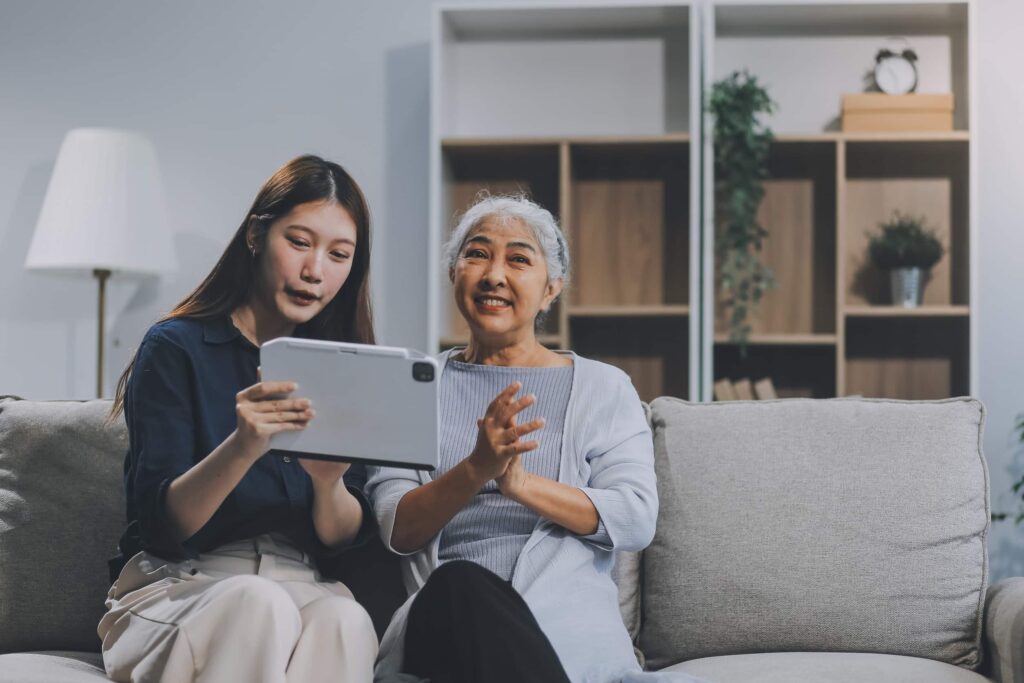Creating a safe, comfortable home for your aging loved ones in Essex County is vital, and it starts with understanding their unique needs. It’s not just about adding grab bars or smart lights; it’s about crafting a space where they feel secure and independent. You’ll want to assess your home for potential hazards and consider modifications that support mobility and convenience. But how do you balance practicality with personal comfort? Let’s explore the essential steps together.
Assessing Your Home’s Current Safety and Comfort Levels
How do you guarantee your home is both safe and comfortable for your aging loved ones? Start by conducting a thorough home inspection to identify any potential hazards. Create a detailed safety checklist that includes key areas like lighting, flooring, and emergency accessibility. Confirm pathways are clear and free from tripping hazards. Check that lighting is adequate in all rooms, especially in hallways and staircases, to prevent falls. Verify that smoke and carbon monoxide detectors are functional and properly placed. Evaluate bathroom safety by confirming grab bars are installed and non-slip mats are used. As you walk through each room, put yourself in their shoes, consider what might pose risks. This careful assessment not only safeguards them but also provides peace of mind for you.
Essential Modifications for Enhanced Accessibility
To guarantee your aging loved ones can navigate their living space with ease, consider making essential modifications that enhance accessibility. Start by installing wheelchair ramps at entrances to eliminate barriers and facilitate smooth changes. These ramps can be customized to fit your home’s design while providing much-needed mobility support. Inside, strategically placed grab bars in bathrooms and along staircases offer stability, reducing the risk of falls. They’re especially helpful near showers, toilets, and any other areas where balance might be a concern. Think about widening doorways to accommodate wheelchairs or walkers, assuring freedom of movement. By focusing on these practical changes, you’re not just improving accessibility; you’re showing empathy and understanding for their needs, fostering a safe, comfortable environment.
Implementing Smart Home Technology for Peace of Mind for your Seniors

While caring for your aging loved ones, incorporating smart home technology can greatly enhance their safety and your peace of mind. Smart lighting and voice activation play pivotal roles. Smart lighting helps prevent falls by automatically illuminating pathways, especially at night. Voice activation allows them to adjust lighting, thermostats, and even call for help without needing to move around.
Here’s a quick look at some smart tech benefits:
| Feature | Benefit | Example Use Case |
| Smart Lighting | Reduces fall risk | Nighttime bathroom trips |
| Voice Activation | Hands-free control | Adjust room temperature |
| Emergency Alerts | Quick help access | Immediate assistance |
Choosing the Right Furniture and Layout for Mobility
Choosing the right furniture and layout for your aging loved ones can greatly enhance their mobility and independence. Focus on optimizing space by arranging furniture to allow clear pathways and selecting ergonomic pieces that support comfort and ease of use. Prioritize accessibility by ensuring items like seating and storage are at appropriate heights and easy to reach.
Space Optimization Techniques
Creating a safe and comfortable environment for your aging loved ones begins with thoughtful space optimization. Consider using space saving solutions like wall-mounted shelves instead of bulky cabinets. These not only free up floor space but also keep essentials within easy reach. Opt for multi functional furniture, such as a lift-top coffee table that can double as a dining surface or a storage ottoman. This approach maximizes space while meeting their daily needs.
Ensure that pathways are wide and clutter-free to accommodate mobility aids like walkers or wheelchairs. Arrange furniture to create a clear flow of movement, minimizing the risk of trips and falls. Prioritize comfort by selecting furniture with firm seating and armrests, providing stability and easier changes from sitting to standing.
Ergonomic Furniture Choices
Having optimized the space for your aging loved ones, now focus on selecting ergonomic furniture that supports their mobility and comfort. Choose pieces that enhance their independence while providing ease of use. Opt for adjustable seating to accommodate various heights and preferences. Look for supportive cushions that offer extra comfort and help maintain proper posture. Here are some considerations for making thoughtful selections:
- Adjustable seating: Offers flexibility for different activities and personal needs.
- Supportive cushions: guarantee comfort and reduce strain on joints.
- Non-slip surfaces: Prevent accidental slips and falls.
- Lightweight furniture: Easy to move and rearrange as needed.
Accessibility Considerations
When planning your home to accommodate aging loved ones, prioritizing accessibility guarantees their safety and independence. Start by selecting furniture that accommodates mobility aids like walkers or wheelchairs. Choose pieces with rounded edges and stable bases to prevent accidents. Consider home modifications such as lowering countertops and installing lever-style door handles for easier access. Arrange furniture to create wide, unobstructed pathways, ensuring seamless movement throughout the home.
Place essential items within easy reach to minimize bending or stretching. You might think about adding grab bars near sitting areas for extra support. Lighting is vital, ensure spaces are well-lit to prevent falls. By thoughtfully designing your home with these considerations, you’ll create a welcoming environment that enhances mobility and promotes an independent lifestyle.
Enhancing Bathroom Safety for Seniors
Although the bathroom is often one of the smallest rooms in a home, it can present significant hazards for seniors. To enhance safety, you should focus on practical solutions that reduce the risk of slips and falls. Installing grab bars is essential; they provide stability and support when using the shower or toilet. Additionally, non-slip surfaces are vital to prevent accidents on wet floors. Consider adding these features:
- Grab bars near the toilet and in the shower for easy access.
- Non-slip mats or strips in the bathtub and on the floor.
- Shower chairs for those needing extra support while washing.
- Handheld showerheads for added convenience and safety.
Creating a Safe and Inviting Outdoor Space
Transforming your outdoor space into a safe and inviting area for aging loved ones is both a thoughtful and practical endeavor. Start by evaluating garden accessibility. Verify there are wide, even paths with non-slip surfaces, reducing the risk of trips and falls. Installing handrails or raised garden beds can offer additional support and comfort.
Consider outdoor seating that’s sturdy and comfortable. Opt for chairs with armrests to assist with sitting and standing. Place these in shaded areas to provide relief from the sun while enjoying the fresh air.
Regularly maintain the space by trimming overgrown plants and removing debris. By making these mindful adjustments, you’ll create a welcoming environment where your loved ones can safely enjoy the serenity of the outdoors.
Personalized Design Tips for Aging in Place

To guarantee your aging loved ones can comfortably stay in their home, start by considering accessible bathroom modifications like grab bars and walk-in tubs. Choose ergonomic furniture that supports their changing needs, reducing strain and enhancing comfort. Finally, integrate smart home technologies that offer convenience and safety, giving both you and your loved ones peace of mind.
Accessible Bathroom Modifications
When guaranteeing your aging loved ones can safely remain in their home, making the bathroom accessible is essential. It’s a place prone to slips and falls, so you should focus on safety features like grab bars and non-slip surfaces. By incorporating these modifications, you can enhance their independence while reducing risk.
Consider these practical tips:
- Install grab bars: Place them near the toilet and in the shower for added support.
- Use non-slip surfaces: Apply non-slip mats or textured tiles on the floor and in the shower.
- Lower sink heights: Adjust sinks for wheelchair accessibility, guaranteeing ease of use.
- Adjust lighting: Guarantee bright, glare-free lighting for better visibility.
These thoughtful changes can create a comfortable and secure environment for your loved ones.
Ergonomic Furniture Choices
While maintaining comfort, it’s crucial to select ergonomic furniture that supports the unique needs of aging individuals. Start with adjustable seating, which allows modifications to height and angle, providing ease when sitting down or standing up. Chairs with supportive cushions can greatly enhance comfort and alleviate pressure on joints, making them ideal for long periods of sitting. Look for furniture that encourages proper posture, as this can help prevent back pain and other discomforts. Opt for materials that are easy to clean and maintain, ensuring lasting durability. Consider the overall layout, ensuring that the furniture doesn’t obstruct pathways, reducing the risk of falls. By thoughtfully choosing ergonomic pieces, you create a nurturing environment that respects both safety and comfort.
Smart Home Technologies
Enhancing the comfort of a home involves not just the physical elements, but also integrating technology that caters to the needs of aging loved ones. By using smart home technologies, you can create a more accessible and safe environment. Consider these practical innovations:
- Voice activated assistants: Simplify tasks such as setting reminders or controlling devices with just a spoken command.
- Smart lighting: Automatically adjust brightness or color based on time of day or presence, reducing risks of falls.
- Security systems: Remote monitoring and instant alerts offer peace of mind and guarantee safety.
- Smart thermostats: Maintain ideal temperatures effortlessly, adapting to your loved one’s comfort needs.
These solutions not only enhance convenience but also promote independence for aging individuals.
Frequently Asked Questions
How Can I Financially Plan for Home Modifications for Seniors?
Start by evaluating your loved one’s needs, then develop savings strategies and budget planning to cover costs. Prioritize modifications, seek grants or assistance programs, and adjust the budget as needed to guarantee safety and comfort without financial strain.
What Are Common Signs That a Home Is Unsafe for Elderly Residents?
You should look for fall hazards like loose rugs, cluttered pathways, and poor lighting. Make certain accessibility features like grab bars, ramps, and wide doorways are present. Prioritize your loved one’s safety by addressing these issues promptly and effectively.
Are There Government Grants Available for Senior Home Modifications?
You can explore government assistance programs offering senior grants for home modifications. These grants help fund essential changes, ensuring your loved ones’ safety. Check local agencies or online resources for eligibility criteria and application processes.
How Do I Involve My Aging Loved One in the Decision-Making Process?
Involve your aging loved one by organizing family meetings. Encourage open discussions to align on shared goals, ensuring they feel valued in decisions. Listen actively, address concerns, and foster a collaborative atmosphere for practical solutions that respect their autonomy.
What Are the Benefits of Hiring a Professional Aging-In-Place Consultant?
Hiring a professional aging-in-place consultant can enhance home safety and provide valuable caregiver support. They assess your loved one’s needs, suggest practical modifications, and guarantee a safe environment, allowing you to focus on caring with peace of mind.
Conclusion
In Essex County, creating a safe and comfortable home for your aging loved ones is both a practical and compassionate endeavor. By evaluating and modifying your space, implementing smart technology, and choosing the right furniture, you guarantee their comfort and safety. Don’t forget to enhance bathroom and outdoor areas for added security. Engage with local resources to further support your efforts. Theresa’s Place #1 Homecare can help in this section. With these steps, you’re fostering an environment where your loved ones can thrive independently and with dignity.

